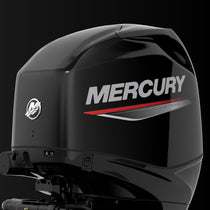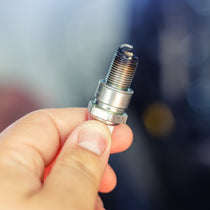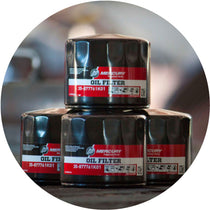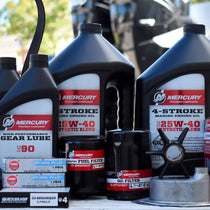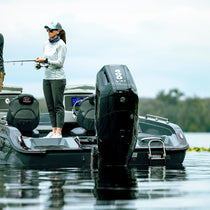Depending on your application and style of boat, your Mercury fuel system may include a fuel-water separating filter. If you have not seen one, follow the routing of your fuel hose from the engine rigging tube backward through the boat. These vary in shape and manufacturer, so be sure to order the identical replacement size for the best fit. Verado owners may not have an inline filter as the engine has a water separator under the cowling.
Shop Recommended Products
Use a filter wrench to loosen the existing filter element and use caution when removing it as it will be filled with gasoline. A clear plastic or glass container is helpful to dump the filter and examine the contents. A small amount of debris is common, as is a small amount of water after the fuel has had a moment to settle. More significant amounts of water would warrant further investigation.

If your filter’s mounting location allows it, pre-fill the replacement filter with some gasoline to make re-priming the fuel system easier. It is also advisable to use a small amount of grease or engine oil to lubricate the o-ring before installation. Spin on and hand tighten only about a half turn to snug.
Move back to the engine and locate the filter element(s) on the engine. The scope of this service will only include the low-pressure fuel filter and fuel water separator if applicable by model. Mercury recommends that owners do not service their high-pressure fuel filters. Depending on your engine model, the water separator filter (or castle filter) may be removed by using a wrench, standard tools, and a little caution. Unplug the water-in-fuel sensor if applicable and spin the cap off of the housing. Replace the filter element with a fresh one, lube the o-ring with grease or oil, and carefully reinstall the cap.
For most other models, the low-pressure fuel filter is inline where the fuel supply line passes down the side of the cowling. On applicable models, locate the Schrader valve on the fuel system. Cover the valve with a rag or towel and depress the valve stem to vent the pressure from the system before service. With the pressure vented, remove the inline filter and replace it with a new one paying particular attention to locate the clamps or zip ties securing the hoses to the filter.
Locate your engine’s primer bulb if applicable and use the primer to pump up the fuel system. You should feel and hear gasoline entering and filling the filter cup. Check for leaks and prime until the bulb becomes firm.
**Pro Tip** Primer bulbs work best when the arrow points up, so use any extra hose in the line to help tilt the bulb to a vertical position. Note that not all installations will make use of a primer bulb.
If you are not already regularly running Mercury Quickare and/or Quickleen through your Mercury fuel system, the 100-hour service interval is an excellent time for a "shock treatment.” Quickare is a fuel system cleaner and top-lube that will help to clean deposits from the tank, lines, carburetors, injectors, and pumps. It breaks up fuel system varnish and will help to prevent gumming.
Quickleen is a fuel system conditioner that also helps to remove carbon deposits. The standard dose is one ounce per ten gallons, but if you are not running the product regularly, you can double that ratio for more cleaning power. Pour the products into the fuel tank fill and run the boat. No additional work is needed. It is a great idea to inspect your fuel tank fill’s o-ring for damage when you add fuel or additives as a damaged o-ring can allow water from rain or boat washing into your fuel system.
Mercury fuel system check - does your fuel-water separating filter have a large amount of water in it?
The problem lies in the very physical nature of ethanol. Ethanol prefers to bond with water vs. the gasoline it has been introduced into and subsequently pumped into your boat's fuel tank. Through the natural process of condensation, being in a water environment and accidental introduction of water into the fuel system, water finds itself in the fuel tank.
Read more about why ethanol gasoline is a problem for outboard engines.

